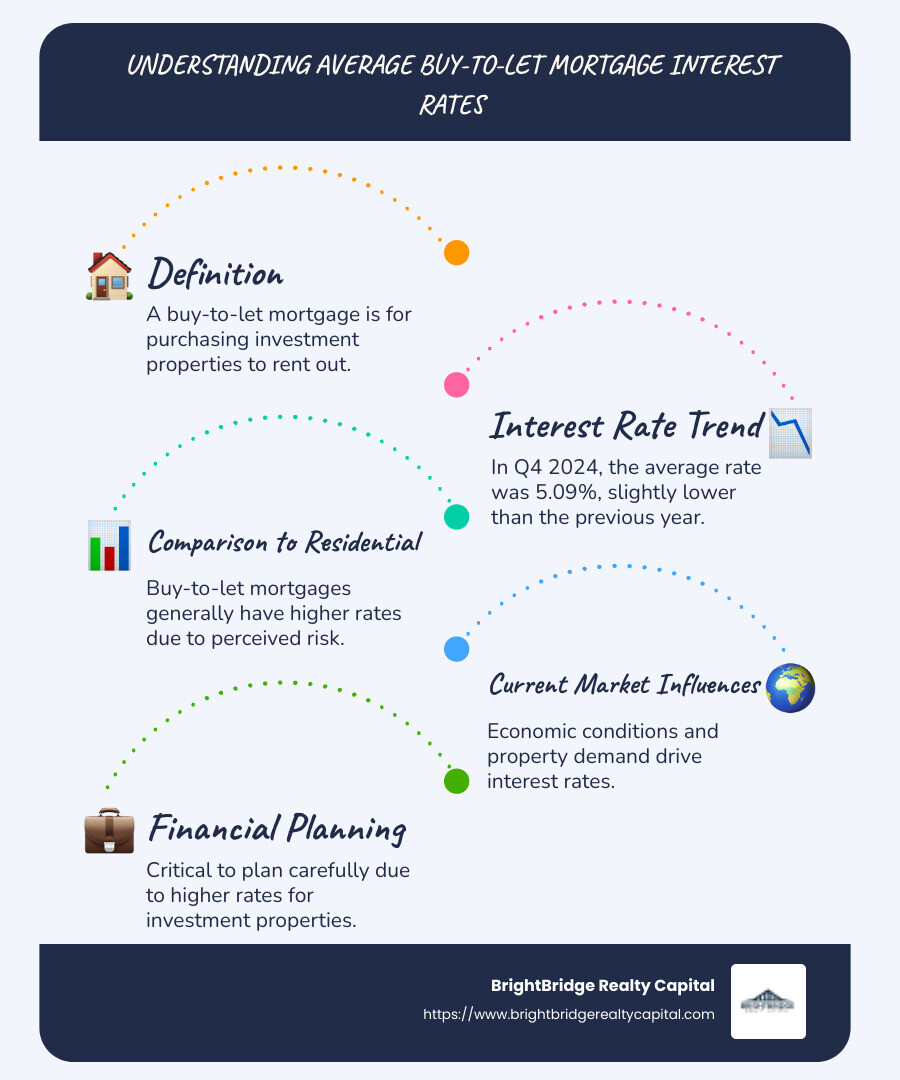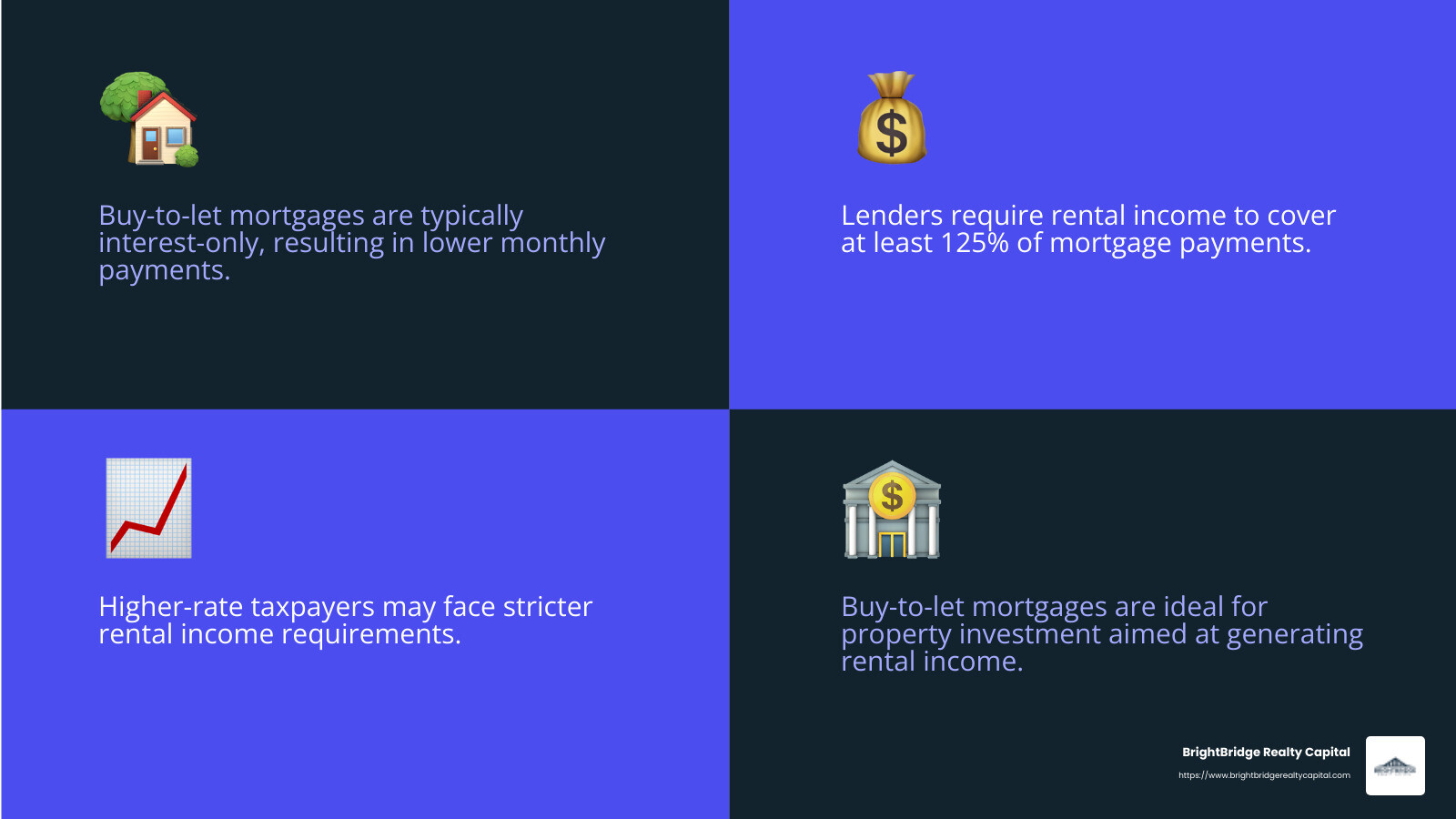The Buy-to-Let Breakdown: Understanding Average Mortgage Interest Rates

The average buy to let mortgage interest rate is a crucial piece of data for property investors considering rental ventures. It's an ever-shifting figure influenced by numerous economic factors, and understanding it can make a significant difference in your investment strategy. For instance, recent data indicates that the average interest rate across new buy-to-let loans in the UK was 5.09% in Q4 2024. This rate, while lower than the previous year, remains above typical residential mortgages, emphasizing the need for careful comparison.
A buy-to-let mortgage allows you to purchase an investment property with the intention of renting it out. These mortgages often have higher interest rates than residential mortgages, due to the added risk perceived by lenders. With properties offering lucrative returns and the rental market thriving, the appeal is clear. However, understanding the nuances of these rates is critical.
Rental properties typically see a greater demand when house prices soar or economic conditions tighten, making buy-to-let a popular option for savvy investors looking to expand their portfolios. However, navigating the higher fees and interest rates associated with buy-to-let mortgages requires careful financial planning and sometimes expert advice.

Terms related to average buy to let mortgage interest rate:
- conventional mortgage rates investment property
- interest rate for investment property today
- refinancing primary residence to investment property
What is a Buy-to-Let Mortgage?
A buy-to-let mortgage is a type of loan specifically designed for those looking to purchase property as an investment, to rent out rather than live in themselves. These mortgages are a popular choice among landlords and property investors who aim to generate rental income.
Interest-Only Mortgages
Most buy-to-let mortgages are structured as interest-only loans. This means that each monthly payment only covers the interest on the loan, not the principal amount borrowed. The benefit? Lower monthly payments. However, at the end of the mortgage term, you'll still owe the original loan amount. Many landlords plan to repay this by selling the property or using savings.
Rental Income and Landlord Requirements
Rental income is a key factor in securing a buy-to-let mortgage. Lenders typically require that the expected rental income covers at least 125% of the mortgage payments. However, some lenders may ask for a higher percentage, especially for higher-rate taxpayers.

Landlord requirements often include a larger deposit compared to residential mortgages. Typically, lenders ask for a deposit of at least 25% of the property's value, but some may require up to 40%. This larger deposit reduces the lender's risk and can also influence the interest rate offered.
Additionally, lenders will assess your creditworthiness, similar to other types of mortgages. A good credit score can lead to better interest rates and terms.
A Note on Regulation
It's worth noting that most buy-to-let mortgages are not regulated by the Financial Conduct Authority (FCA). However, there are exceptions, such as when the borrower or a close family member plans to live in the property at some point. In these cases, the mortgage may be classified as a regulated buy-to-let mortgage with stricter criteria.
Understanding these aspects of buy-to-let mortgages can help you make informed decisions and optimize your investment strategy.
Factors Influencing Average Buy-to-Let Mortgage Interest Rate
When you're considering a buy-to-let property, understanding what affects the average buy-to-let mortgage interest rate can give you a leg up. Let's break down the main factors: risk assessment, deposit size, credit score, and rental yield.
Risk Assessment
Lenders see buy-to-let mortgages as riskier than residential ones. Why? Because there's a higher chance of rental income not covering the mortgage, especially during economic downturns. To offset this risk, lenders often charge higher interest rates.
Interest-only mortgages are common in this space, which means landlords might face a hefty sum at the end of the term. Lenders are cautious and adjust rates to reflect this risk.
Deposit Size
The size of your deposit significantly impacts the interest rate. A larger deposit reduces the lender's risk, as it lowers the loan-to-value (LTV) ratio. Most lenders require at least a 25% deposit, but if you can manage 40% or more, you might snag a better rate.
Why? Because a lower LTV ratio means less risk for the lender. It's like saying, "Hey, I'm serious about this investment!" This confidence can translate into lower interest rates for you.
Credit Score
Your credit score is your financial reputation. A higher score tells lenders you're reliable, which can earn you a more favorable interest rate. If your score is on the lower side, expect to pay more in interest.
Improving your credit score before applying can save you money in the long run. Paying bills on time and reducing outstanding debts can help boost your score.
Rental Yield
Rental yield is the return on your investment property, calculated as a percentage of its value. A higher rental yield shows that the property is a good income generator, which can influence the interest rate offered.
Lenders look at rental yield to ensure that the rental income will cover the mortgage payments. A robust yield can reassure lenders and potentially lower the interest rate.
Current Trends in Buy-to-Let Mortgage Rates
Let's explore what's happening with buy-to-let mortgage rates right now. Understanding these trends can help you make informed decisions about your investment.
Interest Rate Trends
In recent times, buy-to-let mortgage rates have been on a bit of a rollercoaster. As of Q4 2024, the average buy-to-let mortgage interest rate in the UK was 5.09%. This marked a decrease of 0.13 basis points from the previous quarter and a significant drop of 0.61 basis points compared to the same period in 2023. This downward trend is good news for potential landlords, as lower rates can mean more affordable monthly payments.
Fixed vs Variable Rates
When choosing a mortgage, you'll often hear about fixed and variable rates. Here's a quick breakdown:
Fixed Rates: These remain the same for a set period, giving you stability in your monthly payments. As of late 2024, fixed-rate mortgages are popular, with 1.43 million outstanding, a 4.4% increase from the previous year.
Variable Rates: These can change based on the lender's standard variable rate. The number of variable rate loans has decreased by 15.9%, with 518,000 outstanding. This decline suggests that more landlords prefer the predictability of fixed rates, especially in uncertain economic times.
Economic Factors
Several economic factors are influencing buy-to-let mortgage rates:
Interest Rates: The Bank of England's monetary policies play a crucial role. Recent rate cuts in late 2024 have contributed to the decrease in mortgage interest rates. As lenders adjust to these changes, it's important to keep an eye on future announcements.
Rental Yields: The average gross buy-to-let rental yield was 7% in Q4 2024, up from 6.74% the previous year. A higher yield indicates strong rental income potential, which can affect the rates lenders offer.
Market Stability: The buy-to-let sector is a significant part of the UK housing market, accounting for about 9% of the housing stock. However, landlords face challenges like higher interest rates and regulatory costs, which can impact profitability. Despite these pressures, the market remains a robust financial asset for many, with around £300 billion in outstanding mortgage debt.

These trends highlight the dynamic nature of the buy-to-let mortgage market. By understanding the current landscape, you can better steer your investment strategy.
How to Secure the Best Buy-to-Let Mortgage Rates
Securing the best buy-to-let mortgage rates can make a big difference in your investment returns. Here's how to do it effectively:
Comparison Shopping
Start by comparing different mortgage deals. Each lender offers unique rates and terms, so it's crucial to shop around. Use online tools to compare the average buy-to-let mortgage interest rate across different lenders. This can save you thousands over the life of the loan.
Quick Tip: Look at both the initial interest rate and the Annual Percentage Rate of Charge (APRC). The APRC gives a fuller picture of costs over the mortgage term.
Mortgage Brokers
Consider using a mortgage broker. Brokers can access exclusive deals not available directly to the public. They can also help you steer the paperwork and find a mortgage that fits your needs.
"Mortgage brokers remove a lot of the paperwork and hassle of getting a mortgage," notes MoneyfactsCompare. This can be especially helpful if you're new to the buy-to-let market.
Negotiation Strategies
Don't be afraid to negotiate. Use quotes from various lenders as leverage to ask for better terms. Lenders want your business, so they might be willing to offer a lower rate to secure it.
Pro Tip: Improving your credit score and reducing existing debt can strengthen your negotiating position. Lenders are more likely to offer favorable rates to borrowers with strong financial profiles.
By following these strategies, you can secure a buy-to-let mortgage that maximizes your investment returns. Next, we'll answer some frequently asked questions about buy-to-let mortgages.
Frequently Asked Questions about Buy-to-Let Mortgages
What is the average buy-to-let mortgage interest rate?
The average buy-to-let mortgage interest rate can vary significantly depending on several factors, including the lender, the borrower's financial profile, and market conditions. As of the latest data, buy-to-let mortgage rates have been on a rollercoaster, with some lenders offering rates as low as 4% for fixed deals, while others may charge higher rates due to increased risk factors. It's essential to keep an eye on market trends and compare rates from multiple lenders to ensure you're getting a competitive deal.
How do buy-to-let mortgage rates compare to residential rates?
Buy-to-let mortgage rates are generally higher than those for residential properties. This is because lenders view buy-to-let mortgages as riskier investments. The risk is higher because the repayment of the mortgage depends on the rental income generated from the property, which can fluctuate based on market conditions and tenant reliability.
Additionally, buy-to-let mortgages often come with higher fees. Some deals may have product fees that are over £1,000 more than those for residential mortgages. This means that while the initial interest rate might seem attractive, the overall cost could be significantly higher once fees are factored in.
Can first-time buyers get a buy-to-let mortgage?
Yes, first-time buyers can get a buy-to-let mortgage, but it can be challenging. Lenders typically have strict eligibility criteria for these types of loans. First-time buyers may face additional scrutiny because they lack a track record of property ownership and rental management.
Lender Requirements:
- Deposit Size: First-time buyers are usually required to provide a larger deposit, often at least 25% of the property's value.
- Rental Income: Lenders will assess whether the expected rental income will cover the mortgage payments, often requiring it to be 125% to 145% of the mortgage interest.
- Credit Score: A strong credit score is crucial. Lenders are more likely to offer favorable terms to those with excellent credit histories.
- Proof of Income: Lenders may require proof of a stable income to ensure the borrower can cover the mortgage payments should the property become untenanted.
If you're a first-time buyer interested in a buy-to-let mortgage, it's wise to consult with a mortgage broker who can guide you through the process and help you find a lender willing to work with your unique situation.
Conclusion
Navigating buy-to-let mortgages can be complex, but a well-thought-out investment strategy can make all the difference. Whether you're a seasoned investor or just getting started, understanding the intricacies of buy-to-let mortgage interest rates is crucial. These rates are typically higher than those for residential properties due to the perceived risk, so it's important to compare offers and consider all associated costs, including fees.
At BrightBridge Realty Capital, we understand that each investor's journey is unique. Our goal is to provide customized real estate financing solutions that meet your specific needs. With our ability to offer fast closings—often within a week—and competitive rates, we make the process as seamless as possible. Our direct lending approach cuts out the middleman, ensuring you get the best deal without unnecessary delays.
Real estate remains a robust investment option, offering steady cash flow, potential appreciation, and tax benefits. As you plan your investment strategy, consider how a buy-to-let property could diversify your portfolio and provide long-term returns. The key to success in property investment is not just about finding the right property but also securing the best financing.
For more information on how we can assist you with your real estate financing needs, visit our BrightBridge Realty Capital service page. Let us help you bridge the gap with smart real estate financing.


